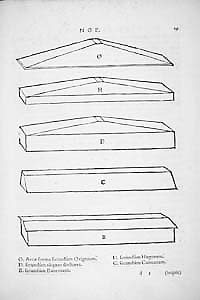The Opera geometrica of the French mathematician Jean Buteo was a collection of tracts on a variety of mathematical questions, beginning with the shape and size of the Ark. Buteo was the first to treat this as an exercise in geometry, so to some extent he set the terms of subsequent debate. He considers the materials used in constructing the Ark, the general design, the overall capacity and the accommodation required to cope with all the animals, while central to the discussion is the size of the cubit. Buteo sees no need to invoke the large ‘geometrical’ cubit for, by limiting the animals to a finite number and by estimating the space they would require, he concludes that they can be accommodated with the necessary provisions. Buteo’s calculations were influential because they vindicated a material Ark.
Buteo’s technique was to reduce the animal units to three – cow, sheep and wolf – and to express the requirements for accommodation and food in terms of equivalent numbers of these animals. This device makes the whole calculation manageable and he was able to fit his animals into the lowest deck, store the hay in the middle, and leave the top deck for people and birds.
Buteo discusses the variety of forms given to the Ark and establishes the problematic in a graphic manner by presenting five designs of Ark on a single page at the end of a section ‘De variis arcæ, & earum scenographia’. The first is attributed to the early Christian scholar Origen, while the second is simply ascribed to ‘aliquos doctores’. Buteo’s own solution is set at the bottom of the group, and is preceded by designs from the twelfth-century Augustinian scholar Hugh of Saint Victor and from the Dominican general Cajetan or Thomas de Vio. Thus Buteo presents the Ark as a problem of conflicting designs, while at the same time locating it within the discourse of geometry. This rhetorical device, with similar examples, was repeated as late as 1697 by the Dutch shipbuilder Cornelis van Yk.
Just as Buteo’s mathematics and its conclusions were widely adopted, so his general design became popular also. It was used, for example, in the illustration included in the Cambridge Bible of 1660, it was adopted by John Wilkins in 1668 and it formed the basis of Kircher’s magnificent Ark of 1675.




